Why Heavy Cream is Essential in Modern Cooking
Heavy cream is a rich dairy product containing at least 36% milk fat that serves as a cornerstone ingredient in kitchens worldwide. From professional restaurant kitchens to home cooking enthusiasts, this versatile cream transforms ordinary dishes into extraordinary culinary experiences.
Quick Heavy Cream Facts:
- Fat Content: 36-40% milk fat (FDA requirement: minimum 36%)
- Common Names: Heavy whipping cream, heavy cream (identical products)
- Best Uses: Whipping, soups, sauces, ice cream, coffee
- Shelf Life: 1-2 weeks refrigerated when unopened
- Calories: 51 calories per tablespoon
- Key Difference: Won’t curdle when boiled (unlike half-and-half)
Heavy cream comes from the natural separation of milk fat that rises to the surface of non-homogenized milk. Modern production uses centrifugal separators to extract this cream layer, which is then pasteurized for safety and often homogenized for consistency.
As Julia Child once wisely said, “If you’re afraid of butter, use cream.” This quote captures why heavy cream has become indispensable for both professional chefs and home cooks seeking to add richness without overwhelming flavors.
Restaurant-grade heavy cream often contains 40% fat, while grocery store versions typically stick to the 36% minimum. This higher fat content explains why restaurant dishes often taste richer and more luxurious than home-cooked versions using standard heavy cream.
For modern food enthusiasts exploring sustainable dining trends, understanding heavy cream’s production and applications helps make informed choices about dairy consumption and potential plant-based alternatives.
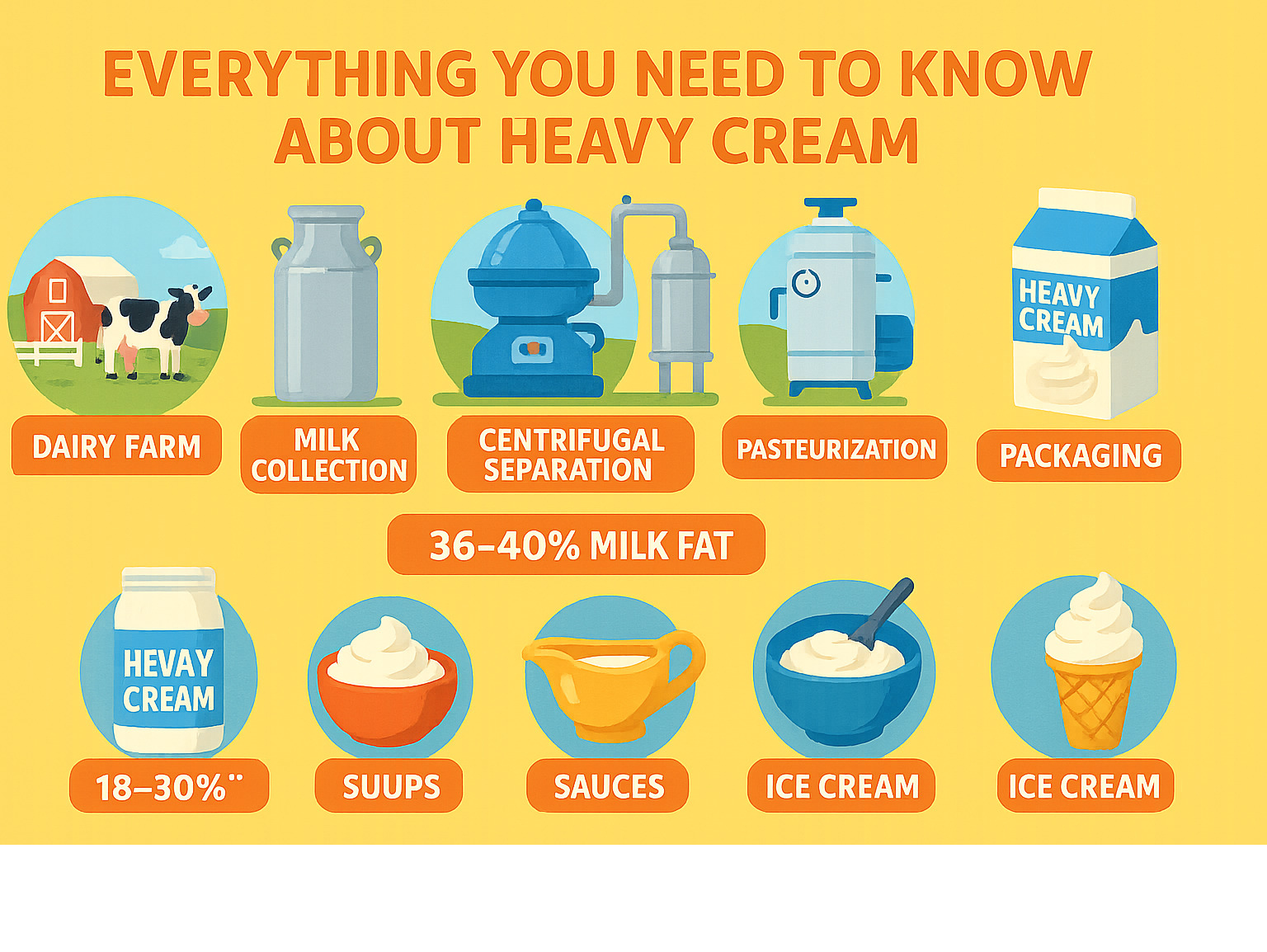
What Is Heavy Cream & How It’s Made
Ever wondered how that gorgeous, rich heavy cream in your coffee gets made? The story starts with fresh milk straight from the dairy farm, where nature does something pretty amazing.
When milk sits undisturbed, the fat naturally rises to the top—kind of like oil floating on water. This creamy layer contains all the good stuff that makes heavy cream so luxurious. By FDA standards, this cream must pack at least 36% milk fat to earn the “heavy cream” title.
Modern dairies don’t wait around for gravity to do its thing, though. They use powerful centrifugal separators that spin milk at incredible speeds, forcing the cream and skim milk to separate instantly. It’s like nature’s process, but way faster and more consistent.
The cream then gets pasteurized to zap any harmful bacteria while keeping all those wonderful flavors intact. Most commercial heavy cream also goes through homogenization, which breaks down fat globules into tiny, uniform pieces. This prevents that annoying separation you sometimes see in older cream containers.
You’ll often spot additives like carrageenan and sodium caseinate on ingredient labels. These stabilizers keep everything smooth and extend shelf life, though some food purists prefer their cream without the extras.
Restaurant-quality heavy cream typically contains 40% fat, which explains why dishes at your favorite bistro taste so incredibly rich compared to home cooking with standard 36% grocery store cream.
Heavy Cream Production Step-by-Step
The journey from farm to table follows a precise path that ensures quality and safety.
Fresh milk collection kicks off the process at modern processing facilities. Centrifugal separators then work their magic, spinning milk at high speeds to separate the cream from skim milk portions.
Next comes fat standardization, where processors adjust the cream to hit that perfect 36-40% fat range. Pasteurization follows, using controlled heat treatment to eliminate pathogens while preserving the cream’s natural goodness.
Homogenization breaks down fat globules for that silky-smooth texture we all love. Finally, sterile packaging protects the cream during distribution to grocery stores and restaurants.
Heavy Cream vs Heavy Whipping Cream—The Label Law
Here’s a fun fact that might surprise you: heavy cream and heavy whipping cream are exactly the same product! FDA regulations require both to contain at least 36% milk fat, and manufacturers can use either name on their labels.
The difference is purely marketing magic. Some brands choose “heavy whipping cream” to highlight the product’s amazing whipping abilities, while others stick with the simpler “heavy cream” label.
Both versions whip to identical volume and stability when properly chilled. The secret lies in fat content, not fancy label names. Scientific research on dairy processing proves that fat percentage directly determines whipping performance and foam stability—so don’t worry about which label you grab at the store!
Heavy Cream Compared to Other Creams
When you’re standing in the dairy aisle wondering which cream to grab, the fat content makes all the difference. Heavy cream sits at the top of the richness scale with its impressive 36-40% fat content, but understanding how it compares to its lighter cousins will help you choose the perfect cream for your culinary trips.
The cream family spans quite a range of fat percentages. Heavy cream leads the pack at 36-40% fat, followed by light whipping cream at 30-36%, light cream at 18-30%, and half-and-half bringing up the rear at 10.5-18%. Regular whole milk contains just 3.25% fat, which explains why it feels so light compared to cream.
Half-and-half gets its name from being equal parts whole milk and heavy cream. While it’s perfect for your morning coffee, it has a frustrating tendency to curdle when things get hot. Try adding it to a simmering soup, and you’ll quickly see why heavy cream is the go-to choice for cooking.
| Cream Type | Fat Content | Best Uses | Heat Stability |
|---|---|---|---|
| Heavy Cream | 36-40% | Whipping, cooking, sauces | Excellent |
| Light Whipping Cream | 30-36% | Light whipping, coffee | Good |
| Light Cream | 18-30% | Coffee, light sauces | Fair |
| Half-and-Half | 10.5-18% | Coffee, cereal | Poor |
If you’re curious about international cream varieties, British double cream contains a whopping 48% fat, while their famous clotted cream reaches 55%. These ultra-rich creams create incredibly luxurious textures, though they’re harder to find in American grocery stores.
Using Heavy Cream in Vodka Sauce
Heavy cream truly shines in vodka sauce because it can handle the heat without throwing a tantrum. When you combine cream with acidic tomatoes and alcohol, lighter creams often curdle and ruin the smooth, silky texture that makes vodka sauce so irresistible.
The secret lies in that high fat content. As you gradually stir heavy cream into your simmering tomato and vodka mixture, those fat molecules create a stable emulsion that won’t break apart. The result is that gorgeous pink sauce that clings perfectly to your pasta.
This stability means you can let your vodka sauce simmer and reduce without worrying about it separating. Half-and-half or light cream would leave you with a curdled mess, but heavy cream stays smooth and creamy throughout the cooking process. More info about Vodka Sauce
Heavy Cream in French Desserts
French pastry chefs have built their reputation on heavy cream, and for good reason. Whether you’re making crème brûlée, chocolate mousse, or ganache, that rich fat content creates the luxurious mouthfeel that defines classic French desserts.
In crème brûlée, heavy cream provides the silky custard base that sets to perfection in the oven. The high fat content ensures your custard won’t curdle during the gentle baking process, creating that smooth, creamy texture beneath the caramelized sugar top.
For chocolate ganache, heavy cream’s fat content is absolutely crucial. When you heat the cream and pour it over chopped chocolate, those fat molecules help create a perfect emulsion. The result is that glossy, smooth ganache that’s ideal for glazing cakes or rolling into truffles. More info about French Desserts
Heavy Cream vs Other Creams for Whipping
When it comes to whipping cream, heavy cream is the undisputed champion. Those fat globules trap air like tiny balloons, creating stable peaks that hold their shape beautifully. You can whip it to soft peaks for a light, airy texture, or continue to firm peaks for more structure.
Light whipping cream can be whipped, but it produces softer, less stable peaks that tend to deflate more quickly. It’s like the difference between a firm handshake and a limp one – both work, but one definitely makes a stronger impression.
Half-and-half and light cream simply don’t have enough fat to trap air effectively, so don’t even bother trying to whip them. However, if you keep whipping heavy cream too long, you’ll end up with butter and buttermilk – which is actually pretty cool if you want to make fresh butter at home!
Cooking, Baking & Whipping with Heavy Cream
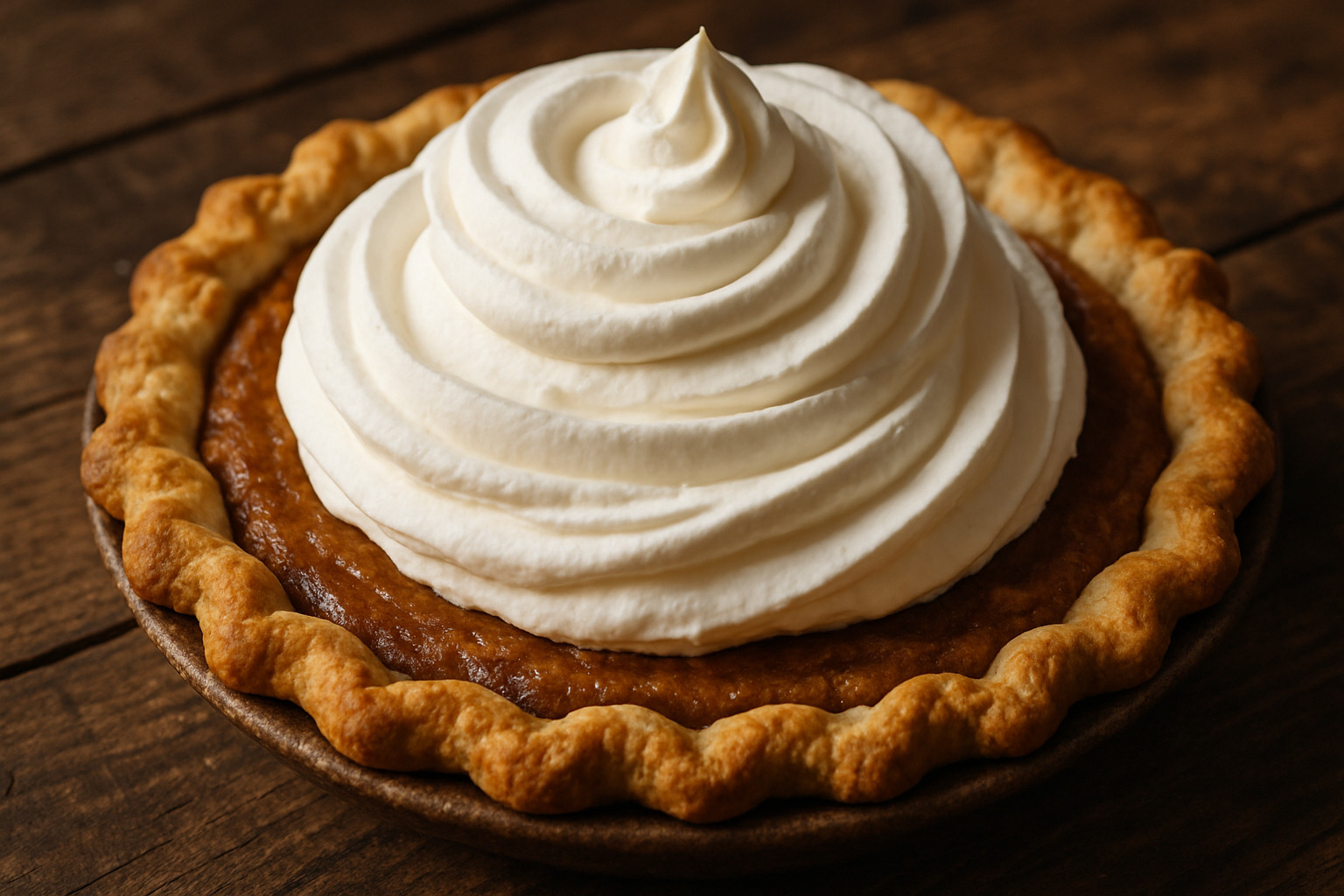
Heavy cream is like the Swiss Army knife of the dairy world—it does so much more than just make fluffy whipped cream. This versatile ingredient transforms ordinary dishes into restaurant-quality creations, whether you’re making a silky soup, rich ganache, or homemade ice cream.
What makes heavy cream so special in cooking is its high fat content, which acts like culinary insurance against disasters. While milk and half-and-half throw tantrums and curdle when things get hot, heavy cream stays calm and smooth even when you’re making a bubbling cream sauce or adding it to coffee.
In the baking world, heavy cream works magic by adding moisture and creating that tender, melt-in-your-mouth texture we all crave. Think of it as the difference between a store-bought scone and one from a fancy bakery—that’s the heavy cream doing its job.
The emulsification properties of heavy cream make it perfect for creating stable sauces that won’t break apart on you. This is why professional chefs reach for it when they need consistent, foolproof results.
How to Whip Heavy Cream Perfectly
Getting perfect whipped cream isn’t rocket science, but a few simple tricks make all the difference. The secret starts before you even open the carton—temperature is everything.
Pop your mixing bowl and beaters into the freezer for about 15 minutes before you start. Cold equipment helps the fat globules in the heavy cream hold their shape better, giving you more stable peaks that won’t deflate the moment you turn your back.
Start whipping on low speed to prevent cream from splattering all over your kitchen (we’ve all been there). Gradually increase to medium-high speed as the cream begins to thicken. If you want sweetened whipped cream, add up to 2 tablespoons of sugar per cup near the end of whipping.
Watch for firm peaks that hold their shape when you lift the beaters. Stop there! Over-whipped cream turns into butter faster than you’d think. If you accidentally go too far, gently fold in a tablespoon of fresh cream to bring it back to life.
Heavy Cream in Savory Dishes
Heavy cream shines brightest when it’s adding richness to savory dishes without stealing the spotlight. In soups and chowders, it provides that velvety body that makes each spoonful feel like a warm hug.
The beauty of using heavy cream in gratins and casseroles is its stability under high heat. While other dairy products might separate or curdle in the oven, heavy cream maintains its smooth, luxurious texture throughout the cooking process.
For the ultimate scrambled eggs, add just a splash of heavy cream instead of milk. The difference is remarkable—you’ll get creamy, restaurant-quality eggs that look like they came from a five-star brunch menu.
When making pan sauces, heavy cream is your best friend because it reduces beautifully without breaking. This makes it perfect for those impressive sauces that make simple chicken or pasta dishes taste gourmet. More info about The Secret Behind Our Signature Sauces & Seasonings
Heavy Cream Substitute at Home
Sometimes you’re halfway through a recipe when you realize the heavy cream container is empty. Don’t panic—there are clever workarounds that can save your dish.
The butter and milk method works wonderfully for liquid applications. Melt 1/4 cup of unsalted butter and whisk it into 3/4 cup of whole milk. This homemade version provides similar richness for soups and sauces, though it won’t whip successfully.
For toppings and lighter applications, try thinning full-fat Greek yogurt with a little milk until you reach the desired consistency. This substitute works especially well when you need something creamy but with a slight tang.
Coconut cream makes an excellent dairy-free alternative. Chill a can of full-fat coconut milk overnight, then skim off the solidified cream layer that rises to the top. This substitute even whips beautifully for those avoiding dairy entirely.
These substitutes work best in specific situations—the butter-milk version excels in liquid applications, while coconut cream handles both liquid and whipped preparations but adds its own distinct flavor to the final dish.
Nutrition, Health Benefits & Concerns
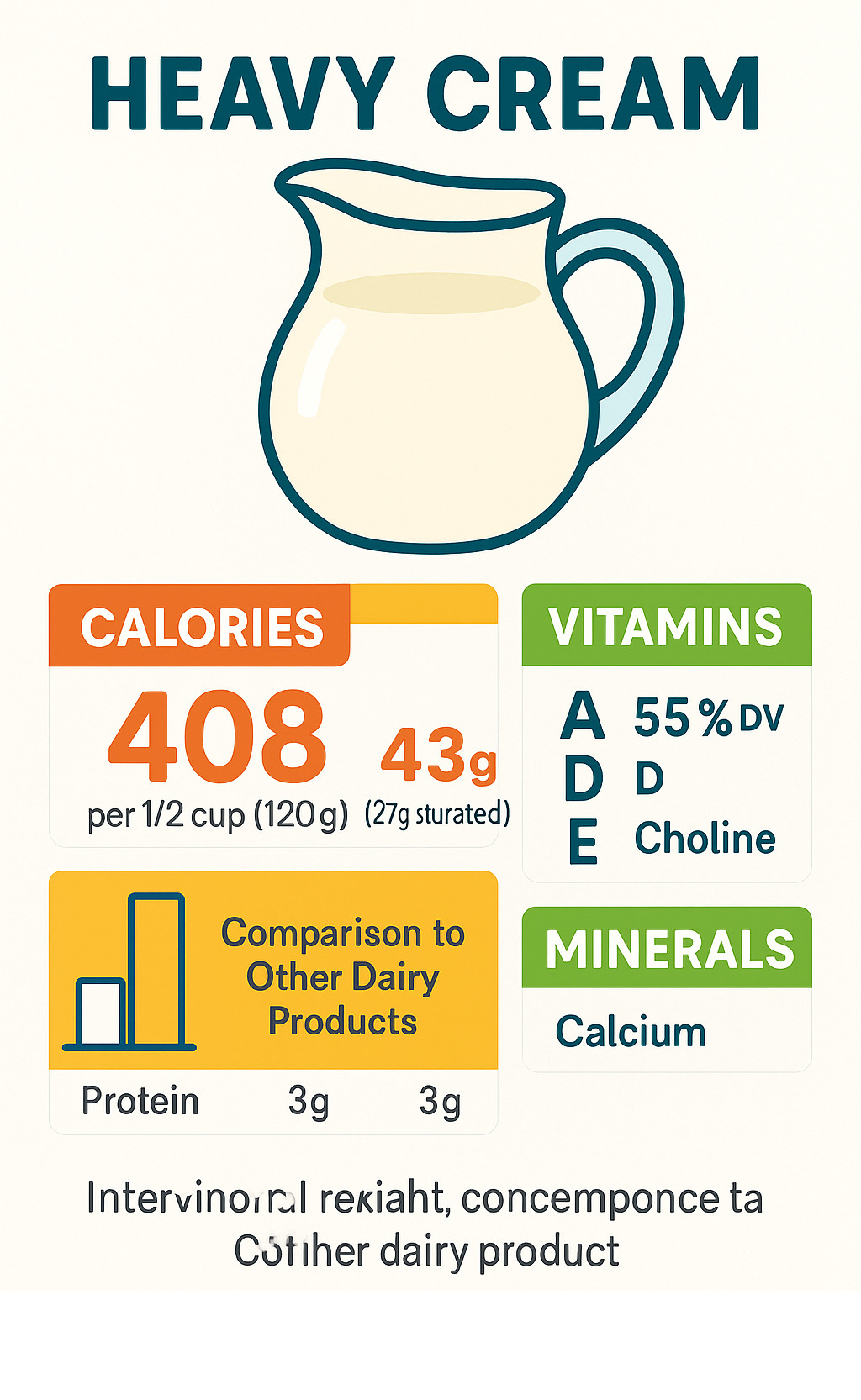
Let’s be honest about heavy cream – it’s not exactly a health food, but it’s not the villain it was once made out to be either. A single tablespoon contains 51 calories with most of those coming from fat, which explains why a little goes a long way in cooking.
The nutritional profile tells an interesting story. Half a cup of heavy cream delivers about 408 calories, 43 grams of fat, 3 grams of protein, and 3 grams of carbohydrates. While those numbers might seem intimidating, most recipes call for much smaller amounts.
What makes heavy cream nutritionally valuable is its impressive vitamin A content – you’ll get 55% of your daily needs in just half a cup. It also provides vitamin D, vitamin E, calcium, and choline, which supports brain function and liver health.
The saturated fat debate has evolved significantly in recent years. While heavy cream contains substantial saturated fat, scientific research on dairy fat and heart health suggests that dairy-based saturated fats may not pose the same risks as previously thought.
Grass-fed heavy cream takes nutrition up a notch, offering higher levels of beneficial fatty acids and antioxidants compared to conventional cream. These compounds may provide additional health benefits, though the research is still developing.
For those following ketogenic diets, heavy cream becomes a valuable ally. Its high fat content and minimal carbohydrates make it perfect for maintaining ketosis while adding richness to meals.
Surprisingly, heavy cream contains less lactose than regular milk. The fat separation process removes much of the lactose, making it potentially tolerable for some people with mild lactose sensitivity.
Is Heavy Cream Healthy?
The answer depends entirely on how you use it and your individual health goals. Recent studies involving over 1,300 participants found something surprising – people who consumed full-fat dairy products actually had lower obesity rates than those who chose low-fat alternatives.
This research challenges decades of dietary advice and suggests that our bodies may handle full-fat dairy differently than we once believed. The key seems to be that heavy cream provides satiety, helping people feel full and satisfied with smaller portions.
For most people, heavy cream fits into a healthy diet when used thoughtfully. A splash in coffee, a dollop on berries, or a small amount in cooking can add pleasure and richness without derailing nutritional goals.
The evidence suggests that quality matters more than quantity. Choosing organic or grass-fed options when possible, and using cream as an improvement rather than a main ingredient, allows you to enjoy its benefits while minimizing potential concerns.
Downsides of Overusing Heavy Cream
Moderation becomes crucial with heavy cream because the calories add up quickly. Those 51 calories per tablespoon can easily become 200+ calories in a single coffee drink if you’re not paying attention.
The high saturated fat content may impact LDL cholesterol levels in some individuals, though responses vary dramatically between people. If you have existing cardiovascular concerns, it’s worth discussing appropriate consumption levels with your healthcare provider.
Many commercial heavy cream products contain carrageenan and other additives for stability and shelf life. While generally recognized as safe, some people prefer to avoid these ingredients and seek out brands with minimal processing.
Lactose intolerance affects more than 65% of adults worldwide, making heavy cream problematic for many people. Even though cream contains less lactose than milk, it can still cause digestive issues for those with severe sensitivities.
Cancer risk studies have examined high-fat dairy consumption, but results remain inconclusive. The current evidence doesn’t suggest that moderate heavy cream consumption poses significant cancer risks for most people.
The bottom line? Heavy cream works best as a culinary tool rather than a dietary staple. Used thoughtfully, it can improve both flavor and nutrition without compromising health goals.
Storage, Substitutions & Sustainable Alternatives
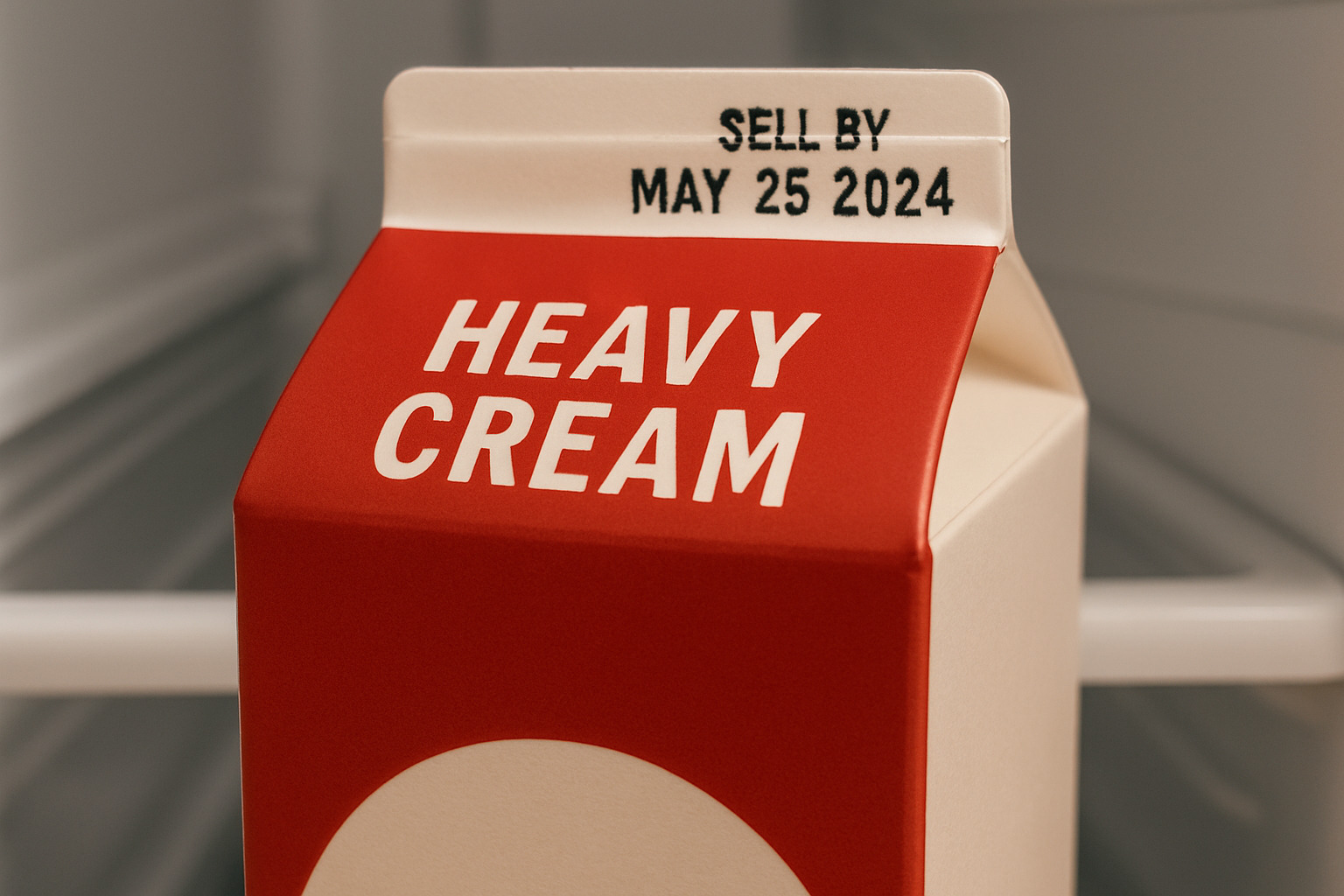
Proper storage extends heavy cream’s shelf life and maintains quality. Unopened cream should be refrigerated at 38-40°F and used by the sell-by date, typically 1-2 weeks from purchase. Once opened, cream should be consumed within 5-7 days for best quality.
Heavy cream can be frozen, though the texture may change slightly upon thawing. Frozen whipped cream dollops work well for dessert garnishes and can be stored for up to 2 months.
If cream separates during storage, gentle stirring usually restores smooth consistency. However, if cream develops off odors, chunky texture, or sour taste, it should be discarded.
How Long Does Heavy Cream Last?
Heavy cream shelf life depends on processing method and storage conditions. Ultra-pasteurized cream lasts longer than regular pasteurized versions but may not whip as well due to protein changes from high-heat treatment.
Unopened cream typically remains fresh for 5-7 days past the sell-by date when properly refrigerated. Once opened, use within one week for optimal quality and safety.
Signs of spoilage include sour smell, chunky texture, or separation that doesn’t resolve with stirring. When in doubt, it’s safer to discard questionable cream rather than risk foodborne illness.
Heavy Cream for Lactose-Intolerant Diners
Heavy cream contains significantly less lactose than milk, making it potentially tolerable for people with mild lactose sensitivity. Two tablespoons of cream contain less than 0.5 grams of lactose compared to 12-13 grams in one cup of milk.
For those who cannot tolerate any dairy, several alternatives provide similar richness:
Dairy-Free Heavy Cream Alternatives:
- Coconut cream (from chilled full-fat coconut milk)
- Cashew cream (blended soaked cashews with water)
- Commercial plant-based heavy cream alternatives
Homemade Heavy Cream & Whipping Feasibility
Homemade heavy cream substitutes using butter and milk provide similar richness for cooking applications but cannot be whipped successfully. The emulsion lacks the structural properties of true heavy cream needed for stable foam formation.
The homemade version works well for:
- Enriching soups and sauces
- Coffee and tea improvement
- Baking applications requiring liquid cream
- Pasta sauce bases
However, it cannot replace heavy cream for whipped applications, ice cream making, or recipes requiring the cream to hold its shape.
Frequently Asked Questions About Heavy Cream
Can I whip plant-based heavy cream alternatives?
The short answer is sometimes, but don’t expect miracles! Coconut cream from a chilled can of full-fat coconut milk whips surprisingly well when you follow the right technique. Pop that can in the fridge overnight, then scoop out only the thick, solid cream that separates at the top.
Many commercial plant-based whipping creams now include clever stabilizers and emulsifiers to help them perform more like dairy heavy cream. However, they rarely achieve the same impressive volume or rock-solid stability that traditional heavy cream delivers. Think of them as enthusiastic understudies rather than the lead performer.
The texture and flavor will be noticeably different too. Coconut cream brings its own tropical notes, which can be delightful in some desserts but might not work for every application.
Why does heavy cream curdle less than milk in hot soups?
This is where heavy cream really shows off its superpowers! The secret lies in that luxurious fat content we’ve been talking about. All that fat acts like a protective shield around the proteins, preventing them from clumping together when things get hot and steamy.
When you add regular milk or half-and-half to acidic ingredients like tomatoes or wine, the proteins panic and huddle together, creating those unappetizing curdles. Heavy cream’s high fat content keeps everything calm and collected, even when the heat is on.
This is why professional chefs reach for heavy cream when making cream soups, vodka sauce, or any dish that needs to simmer without breaking. The fat essentially buffers the proteins against both acid and high temperatures, keeping your sauce silky smooth instead of looking like cottage cheese gone wrong.
How can I rescue over-whipped heavy cream?
Don’t panic if you’ve gone a bit too far with the whisk! Over-whipped heavy cream that’s starting to look grainy or separated can often be saved with a gentle touch and a little fresh reinforcement.
Stop whipping immediately and grab a spatula. Gently fold in one to two tablespoons of fresh heavy cream, working slowly and carefully. This fresh cream helps restore the smooth emulsion and prevents your cream from completing its change into butter and buttermilk.
The key word here is gentle. Resist the urge to keep whipping or beating—that will only push you further down the butter-making path. If your cream has already gone too far and looks completely separated, accept the mistake! You’re halfway to homemade butter, which isn’t such a bad consolation prize after all.
Conclusion
Heavy cream stands as one of cooking’s most remarkable ingredients—a simple dairy product that transforms ordinary dishes into something truly special. From that first spoonful stirred into morning coffee to the final dollop crowning a homemade pie, this rich cream brings joy to countless culinary moments.
We’ve explored how heavy cream earns its place in kitchens worldwide through pure science. That minimum 36% fat content isn’t just a number—it’s what makes cream soups silky instead of curdled, pasta sauces luxurious instead of thin, and whipped cream stable enough to hold its peaks. Understanding these properties helps us cook with confidence and achieve consistent results.
The journey from farm to table reveals heavy cream’s fascinating production process. Modern centrifugal separators may have replaced the old method of skimming cream by hand, but the end result remains the same: a versatile ingredient that connects us to generations of cooks who understood good food starts with quality ingredients.
Heavy cream certainly comes with nutritional considerations. Those 51 calories per tablespoon add up quickly, and the saturated fat content deserves attention. Yet emerging research suggests that full-fat dairy might not be the villain we once thought. As with most foods, moderation and personal dietary needs should guide our choices.
For those avoiding dairy, the growing world of plant-based alternatives offers exciting possibilities. While coconut cream and cashew-based substitutes may not perfectly mimic every property of heavy cream, they open doors for everyone to enjoy rich, satisfying dishes regardless of dietary restrictions.
Perhaps most importantly, heavy cream reminds us that cooking is both art and science. Whether we’re whisking it into a classic French sauce or experimenting with modern fusion dishes, understanding our ingredients helps us create better food and more memorable dining experiences.
The Dining Destination invites you to explore more creamy creations and sustainable ingredient choices in our comprehensive dining guides—Find inspiring dining guides.

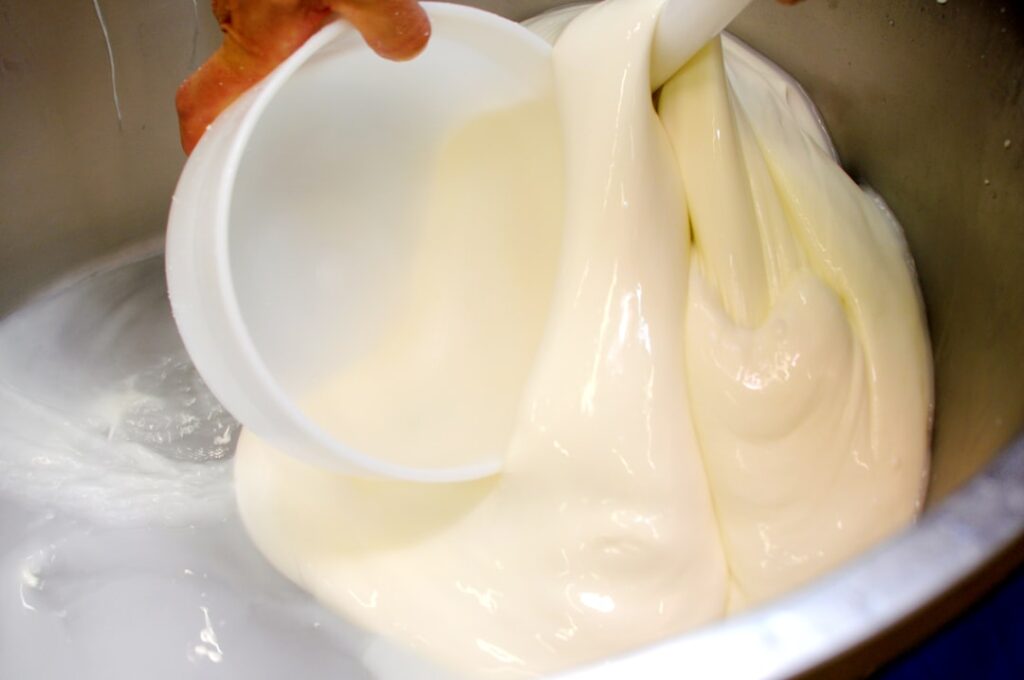






1 thought on “Everything You Need to Know About Heavy Cream”
Pingback: How to Make Alfredo Sauce the Right Way - The Dining Destination
Comments are closed.